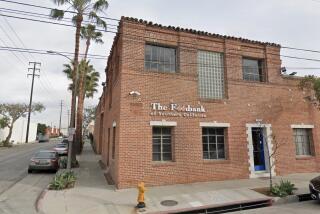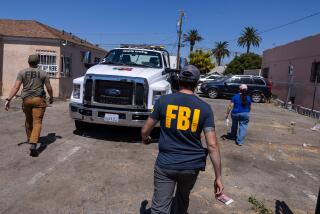FBI Will Probe Thousands of Fraud Claims at Area S&Ls;, Banks
The FBI has received thousands of allegations involving fraud at thrifts and other financial institutions in Southern California, providing further evidence that the area is second only to Texas as a center of savings and loan wrongdoing.
In a telephone interview with The Times, FBI Director William S. Sessions provided the most specific numbers yet showing how deep savings and loan fraud may run in Southern California. His comments came a week after he told a House Banking Committee hearing in Dallas that the FBI has found “pervasive” fraud in the S&L; industry that he called “truly a national crisis.”
Sessions said, as an example, that the FBI has received 16,000 allegations of potential fraud involving losses under $100,000 at financial institutions in its Southern California area, which runs from San Luis Obispo County south, excluding the San Diego area. That number is nearly 80% of the total allegations received nationwide for that specific category.
“That is a large number, and we will be pursuing those with the resources we have,” Sessions said.
Sessions said 179 allegations of fraud involving $100,000 to $1 million in losses have been received in Southern California, with another 20 involving $1 million or more in potential losses. Although the FBI does not break down how many allegations involve banks as opposed to thrifts, other experts said S&L; fraud may well account for most of the allegations even though commercial banks in the area outnumber thrifts by nearly three to one.
The allegations that Sessions cited are called “unaddressed referrals” by the FBI, which means the allegations have been forwarded to the agency, typically by regulators or officials at financial institutions. The allegations are ultimately reviewed and investigated.
In some cases, they are relatively small crimes, such as embezzlement by tellers, and may not even result in criminal charges. In addition, the collapse of a single institution can often account for dozens of allegations.
Still, those numbers and others provided by Sessions bolster the widely held belief that Southern California is the nation’s second worst area for S&L; fraud.
S&L; fraud can involve any number of crimes. It can include outright looting of deposits, inflated appraisals, swapping loans between thrifts to make one look sounder than it is, “straw buyers” who purchase property through phony transactions and kickbacks paid by borrowers to thrift officers.
Sessions said the FBI now has 235 cases involving losses of $100,000 in Southern California that have advanced from initial stages to active investigations. That number is second only to 286 cases in Texas, FBI officials said, where the nation’s S&L; debacle had its greatest impact and where much of the federal government’s investigative efforts have been centered so far.
Assistant U.S. Atty. Terree Bowers, chief of the Justice Department’s major fraud section in Los Angeles and coordinator of a bank fraud group including officials from several federal and state agencies, echoed Sessions’ comments. Bowers said overall losses related to fraud at Southland financial institutions could easily total more than $1 billion.
“It’s not an unreasonable estimate,” Bowers said.
He said the number of cases involving potential losses of more than $100,000 in Southern California being handled by the FBI and U.S. Attorney’s Office may be closer to 300 by now. Bowers added that there are 90 major investigations involving losses of $1 million or more.
Sessions previously disclosed that the FBI is adding 27 new special agents and 14 accountants to its Los Angeles office to handle S&L; cases, paid for by money allocated under last year’s thrift bailout bill. In addition, the U.S. Attorney’s Office has disclosed that it is adding 15 positions allocated specifically to prosecute cases involving S&L; fraud.
Pressure to catch S&L; crooks has intensified in recent weeks as the estimated cost of the nation’s thrift fiasco has grown dramatically, with one government estimate going as high as $500 billion. In addition, authorities are being criticized for taking so long to bring charges against executives at some of the nation’s largest failed thrifts, many of which went under several years ago.
Sessions said prosecuting thrift cases is difficult because they are complex, but added that going after S&L; looters is needed to restore public faith in financial institutions.
“The American public relied upon banking institutions and financial institutions being soundly managed by people who were honest. Therefore, it is absolutely essential that this program go forward to the end no matter how long that takes,” Sessions said.
More to Read
Inside the business of entertainment
The Wide Shot brings you news, analysis and insights on everything from streaming wars to production — and what it all means for the future.
You may occasionally receive promotional content from the Los Angeles Times.










